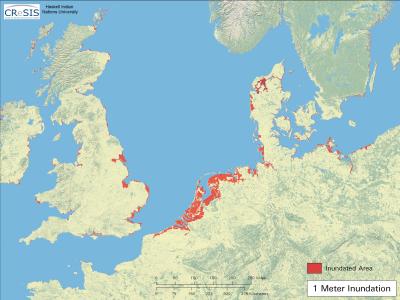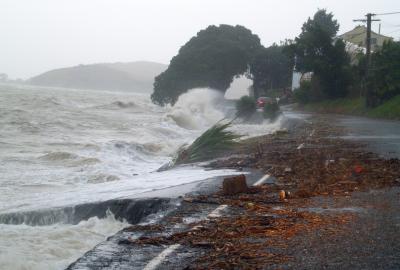
Caption: Map showing the inundated area for a 1 m rise in sea level.
New research indicates
that the ocean could rise in the next 100 years to a meter higher than
the current sea level – which is three times higher than predictions from
the UN's Intergovernmental Panel on Climate Change, IPCC. The groundbreaking
new results from an international collaboration between researchers from
the Niels Bohr Institute at the University of Copenhagen, England and Finland
are published in the scientific journal Climate Dynamics.
A rise in sea level in the future as in the
past
|
http://www.lemonde.fr/ LEMONDE.FR avec AFP 
Le bidonville de Makoko, à Lagos, qui accueille les migrants venus des campagnes, est dores et déjà menacé par la montée des eaux que provoque le réchauffement climatique. | DR Trois grandes villes portuaires d'Afrique – Le Cap, Lagos et Alexandrie – sont menacées par la montée du niveau des eaux due au réchauffement climatique. Cette crue pourrait provoquer le déplacement de millions de personnes, ont estimé, mercredi 14 janvier, des scientifiques, lors d'une conférence internationale sur le changement climatique organisée au Cap, en Afrique du Sud. "Le risque de catastrophe est élevé quand la probabilité d'un danger est grande, quand la vulnérabilité face aux dégâts de ce danger est grande et quand la capacité à gérer les conséquences de cette événement est faible", explique Geoff Brundrit, du Réseau global d'observation des océans en Afrique. Or de nombreux pays africains n'ont pas de "résistance" face à des tempêtes de plus en plus dévastatrices et n'ont pas fini de se remettre du passage de l'une d'entre elles qu'ils sont déjà frappés par la suivante. A Lagos, au Nigeria, ville la plus densément peuplée d'Afrique avec plus de 15 millions d'habitants, les tempêtes inondent déjà les bas quartiers, et des étendues de terres pourraient être submergées par la montée du niveau de la mer. A Alexandrie (Egypte), une élévation du niveau des eaux de seulement cinquante centimètres mettrait les deux-tiers de la population au niveau de la mer, avec des risques accrus d'inondation. Au Cap, de larges étendues de la zone industrielle, des promenades et des propriétés du bord de mer peuvent être touchées par une hausse de 2,5 mètres du niveau de la mer dans les vingt-cinq prochaines années, entraînant des millions de dollars de dégâts. Les îles Fidji sous les eaux http://www.lemonde.fr/ LE MONDE 
Des milliers d'habitants ont dû quitter leurs maisons, et les touristes ont été sommés de rester dans leurs hôtels. De mémoire de Fidjien, on n'avait pas connu de telles inondations depuis au moins une génération. Mercredi 14 janvier, le bilan était de onze morts. Des milliers d'habitants ont dû quitter leurs maisons, et les touristes ont été sommés de rester dans leurs hôtels. Les autorités ont proclamé l'état d'urgence et imposé des couvre-feux afin d'éviter le pillage des zones évacuées. La population a reçu la consigne de gagner des terres situées en hauteur, avant l'arrivée de nouvelles pluies prévue dans la semaine. "On prévoit de grands vents et une mer agitée, et nous conseillons à la population de rester chez elle ou d'aller plus en hauteur", a déclaré le directeur de la météorologie nationale. Les Fidjiens circulent à bord de radeaux de bambou dans les rues inondées, pour acheminer personnes et vivres. De nombreuses îles du Pacifique ont été touchées par ce phénomène, que certains spécialistes attribuent au changement climatique: la montée du niveau des mers, conjuguée avec des grandes marées et des dépressions tropicales, risque de multiplier les inondations côtières dans la région. La Micronésie, les îles Marshall, la Papouasie-Nouvelle-Guinée et les îles Salomon ont été les premières touchées, dès décembre 2008. [1] See also interview on video with geophysicist Aslak Grinsted, Ph.D. on the EurekAlert Multimedia site. Aslak Grinsted, geophysicist, PhD. Centre for Ice and Climate, Niels Bohr Institute, University of Copenhagen, +45 3138-0716, ag@glaciology.net Contact: Gertie Skaarup skaarup@nbi.dk 453-532-5320 University of Copenhagen |

